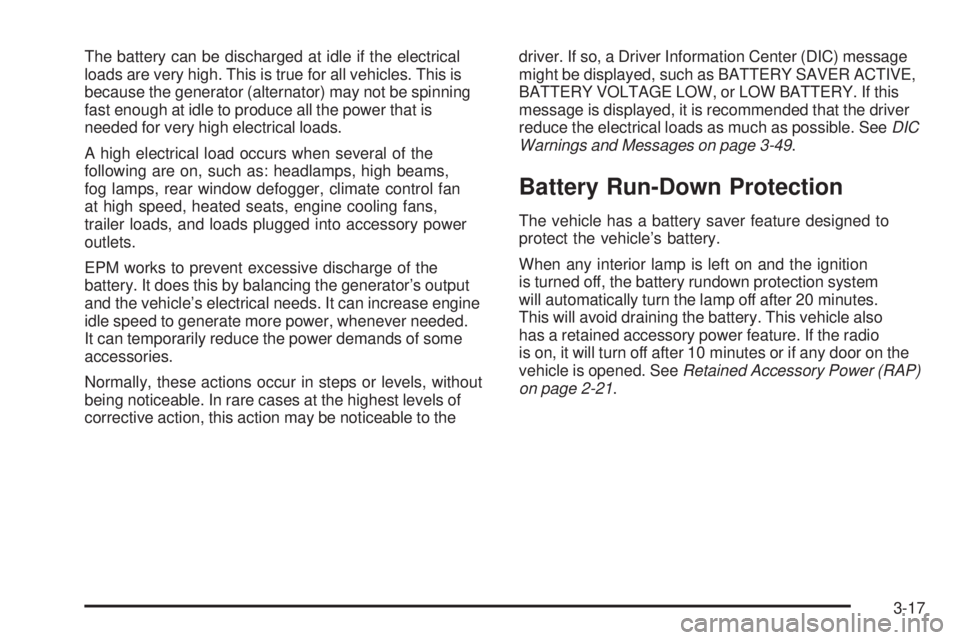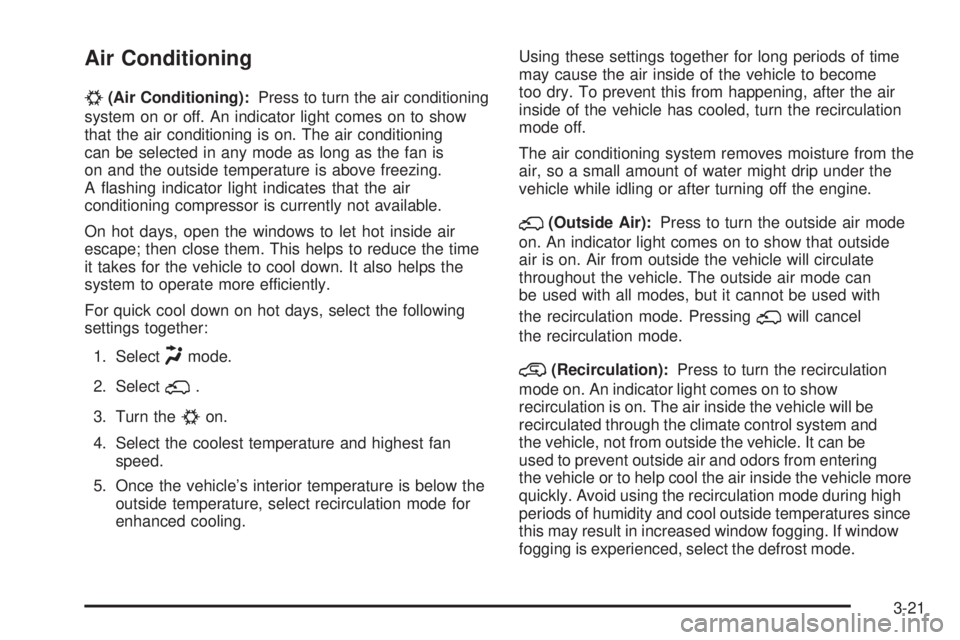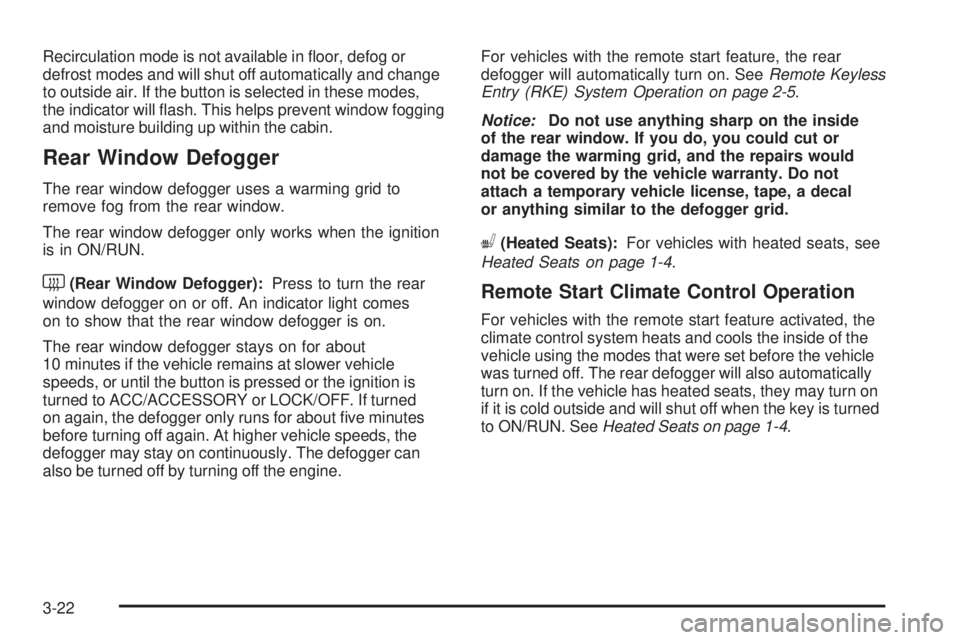2009 PONTIAC TORRENT window
[x] Cancel search: windowPage 129 of 436

The main components of the instrument panel are the following:
A.Outlet Adjustment on page 3-23.
B.Turn Signal/Multifunction Lever on page 3-7.
C.Instrument Panel Cluster on page 3-25.
D.Windshield Wipers on page 3-8.
E.DIC Operation and Displays on page 3-42.
F.Hazard Warning Flashers on page 3-6.
G.Passenger Airbag Status Indicator on page 3-29.
H.Rear Window Wiper/Washer on page 3-10.
Fog Lamps on page 3-14.
I.Outside Power Mirrors on page 2-37.
J.Instrument Panel Brightness on page 3-15.K.Cruise Control on page 3-10.
L.Tilt Wheel on page 3-6.
M.Horn on page 3-6.
N.Audio Steering Wheel Controls on page 3-118.
O.Audio System(s) on page 3-64.
P. Shift Lever. SeeShifting Into Park on page 2-32.
Q.Traction Control System (TCS) on page 4-7.
R.Power Windows on page 2-15.
S.Climate Control System on page 3-19.Heated Seats
on page 1-4(If Equipped).
T.Glove Box on page 2-42.
3-5
Page 133 of 436

6(Delay Adjustment):Move the lever to the delay
position to choose a delayed wiping cycle. Turn the
intermittent adjust band down for a longer delay or
up for a shorter delay.
9(Off):Turns off the windshield wipers.
8(Mist):Move the lever all the way down to mist and
release for a single wiping cycle. The windshield wipers
stop after one wipe and the lever returns to its starting
position. Hold the lever on mist longer for more wipes.
Clear ice and snow from the wiper blades before
using them. If they are frozen to the windshield,
gently loosen or thaw them. If the blades do become
damaged, install new blades or blade inserts.
SeeWindshield Wiper Blade Replacement on
page 5-47.
Heavy snow or ice can overload the wiper motor.
A circuit breaker will stop the motor until it cools
down. Clear away snow or ice to prevent an
overload.
Windshield Washer
{CAUTION:
In freezing weather, do not use your washer until
the windshield is warmed. Otherwise the washer
�uid can form ice on the windshield, blocking your
vision.
There is a button marked with the windshield washer
symbol at the end of the windshield wiper lever. Press
this button to spray washer �uid on the windshield.
The wipers will run for a few cycles to clear the window
and then either stop or return to your preset speed.
For more wash cycles, press and hold the button longer.
3-9
Page 134 of 436

Rear Window Wiper/Washer
The rear wiper and rear wash buttons are located on
the instrument panel above the audio system.
Z(Rear Wiper):Press to turn the rear wiper on and
off. When the wiper is on it runs intermittently at a
preset speed.
Y(Wash):Press to spray washer �uid on the rear
window. The window wiper will also come on. Release
the button when enough �uid has been sprayed on
the window. The rear wiper will run a few more cycles
after it is released. If the rear wiper function was already
on, prior to pressing the wash button, it stays on until
the wiper button is pressed again.
The rear window washer uses the same �uid that is
in the windshield washer reservoir. SeeWindshield
Washer Fluid on page 5-31.
Cruise Control
Cruise control lets a speed of about 25 mph (40 km/h)
or more be maintained without keeping your foot on
the accelerator. Cruise control does not work at speeds
below 25 mph (40 km/h).
When the brakes are applied, the cruise control
shuts off.
If the vehicle is in cruise control and the Traction Control
System (TCS) begins to limit wheel spin, the cruise
control automatically disengages. SeeTraction Control
System (TCS) on page 4-7. When road conditions allow,
the cruise control can be used again.
{CAUTION:
Cruise control can be dangerous where you cannot
drive safely at a steady speed. So, do not use the
cruise control on winding roads or in heavy traffic.
Cruise control can be dangerous on slippery roads.
On such roads, fast changes in tire traction can
cause excessive wheel slip, and you could lose
control. Do not use cruise control on slippery roads.
3-10
Page 141 of 436

The battery can be discharged at idle if the electrical
loads are very high. This is true for all vehicles. This is
because the generator (alternator) may not be spinning
fast enough at idle to produce all the power that is
needed for very high electrical loads.
A high electrical load occurs when several of the
following are on, such as: headlamps, high beams,
fog lamps, rear window defogger, climate control fan
at high speed, heated seats, engine cooling fans,
trailer loads, and loads plugged into accessory power
outlets.
EPM works to prevent excessive discharge of the
battery. It does this by balancing the generator’s output
and the vehicle’s electrical needs. It can increase engine
idle speed to generate more power, whenever needed.
It can temporarily reduce the power demands of some
accessories.
Normally, these actions occur in steps or levels, without
being noticeable. In rare cases at the highest levels of
corrective action, this action may be noticeable to thedriver. If so, a Driver Information Center (DIC) message
might be displayed, such as BATTERY SAVER ACTIVE,
BATTERY VOLTAGE LOW, or LOW BATTERY. If this
message is displayed, it is recommended that the driver
reduce the electrical loads as much as possible. SeeDIC
Warnings and Messages on page 3-49.
Battery Run-Down Protection
The vehicle has a battery saver feature designed to
protect the vehicle’s battery.
When any interior lamp is left on and the ignition
is turned off, the battery rundown protection system
will automatically turn the lamp off after 20 minutes.
This will avoid draining the battery. This vehicle also
has a retained accessory power feature. If the radio
is on, it will turn off after 10 minutes or if any door on the
vehicle is opened. SeeRetained Accessory Power (RAP)
on page 2-21.
3-17
Page 143 of 436

Climate Controls
Climate Control System
The heating, cooling, and ventilation for the vehicle
can be controlled with this system. For vehicles with the
remote start feature, the climate control system functions
as part of the remote start feature. SeeRemote Keyless
Entry (RKE) System Operation on page 2-5.
A. Fan Control
B. Outside Air
C. Temperature Control
D. Recirculation
E. Air Delivery Mode
ControlF. Air Conditioning
G. Heated Seats
H. Rear Window
Defogger
9(Fan Control):Turn clockwise or counterclockwise
to increase or decrease the fan speed. To turn the fan off,
turn the fan knob all the way counterclockwise. In any
setting other than off, the fan runs continuously with
the ignition on. The fan must be turned on to run the
air conditioning compressor. There will be some air�ow
noticeable from the various outlets when driving, even
with the fan in the off position. This is so fresh air is
always available in the vehicle. To turn off the air
completely, turn the fan to
9and select the
recirculation button.
Temperature Control:Turn clockwise or
counterclockwise to increase or decrease the
temperature inside the vehicle.
Air Delivery Mode Control:Turn clockwise or
counterclockwise to change the direction of the
air�ow inside the vehicle.
There is one position between each mode to �nely
adjust air�ow position.
3-19
Page 144 of 436

Select from the following modes:
H(Vent):Air is directed to the instrument panel
outlets.
)(Bi-Level):Air is divided between the instrument
panel outlets and the �oor outlets.
6(Floor):Air is directed to the �oor outlets with some
air directed to the windshield.
When this mode is selected, the system turns the
recirculation mode off. Recirculation mode cannot be
selected while in �oor mode. This helps to prevent
window fogging.
-(Defog):This mode clears the windows of fog or
moisture. Air is directed to the windshield, side window
outlets, and �oor outlets. In this mode, the system turns
the recirculation mode off and runs the air conditioningcompressor unless the outside air is at or below freezing.
Recirculation mode cannot be selected while in defog
mode. This helps prevent window fogging. To defog the
windows faster, turn the temperature knob clockwise to
the warmest setting.
0(Defrost):This mode removes fog or frost from the
windshield more quickly. Air is directed to the windshield,
with some air directed to the side window outlets and the
�oor outlets. In this mode, the system turns the
recirculation mode off and runs the air conditioning
compressor unless the outside air is at or below freezing.
Recirculation mode cannot be selected while in defrost
mode. This helps prevent window fogging. To defrost the
windows faster, turn the temperature knob clockwise to
the warmest setting.
For best results, clear all snow and ice from the
windshield before defrosting.
3-20
Page 145 of 436

Air Conditioning
#
(Air Conditioning):Press to turn the air conditioning
system on or off. An indicator light comes on to show
that the air conditioning is on. The air conditioning
can be selected in any mode as long as the fan is
on and the outside temperature is above freezing.
A �ashing indicator light indicates that the air
conditioning compressor is currently not available.
On hot days, open the windows to let hot inside air
escape; then close them. This helps to reduce the time
it takes for the vehicle to cool down. It also helps the
system to operate more efficiently.
For quick cool down on hot days, select the following
settings together:
1. Select
Hmode.
2. Select
;.
3. Turn the
#on.
4. Select the coolest temperature and highest fan
speed.
5. Once the vehicle’s interior temperature is below the
outside temperature, select recirculation mode for
enhanced cooling.Using these settings together for long periods of time
may cause the air inside of the vehicle to become
too dry. To prevent this from happening, after the air
inside of the vehicle has cooled, turn the recirculation
mode off.
The air conditioning system removes moisture from the
air, so a small amount of water might drip under the
vehicle while idling or after turning off the engine.
;(Outside Air):Press to turn the outside air mode
on. An indicator light comes on to show that outside
air is on. Air from outside the vehicle will circulate
throughout the vehicle. The outside air mode can
be used with all modes, but it cannot be used with
the recirculation mode. Pressing
;will cancel
the recirculation mode.
@(Recirculation):Press to turn the recirculation
mode on. An indicator light comes on to show
recirculation is on. The air inside the vehicle will be
recirculated through the climate control system and
the vehicle, not from outside the vehicle. It can be
used to prevent outside air and odors from entering
the vehicle or to help cool the air inside the vehicle more
quickly. Avoid using the recirculation mode during high
periods of humidity and cool outside temperatures since
this may result in increased window fogging. If window
fogging is experienced, select the defrost mode.
3-21
Page 146 of 436

Recirculation mode is not available in �oor, defog or
defrost modes and will shut off automatically and change
to outside air. If the button is selected in these modes,
the indicator will �ash. This helps prevent window fogging
and moisture building up within the cabin.
Rear Window Defogger
The rear window defogger uses a warming grid to
remove fog from the rear window.
The rear window defogger only works when the ignition
is in ON/RUN.
<(Rear Window Defogger):Press to turn the rear
window defogger on or off. An indicator light comes
on to show that the rear window defogger is on.
The rear window defogger stays on for about
10 minutes if the vehicle remains at slower vehicle
speeds, or until the button is pressed or the ignition is
turned to ACC/ACCESSORY or LOCK/OFF. If turned
on again, the defogger only runs for about �ve minutes
before turning off again. At higher vehicle speeds, the
defogger may stay on continuously. The defogger can
also be turned off by turning off the engine.For vehicles with the remote start feature, the rear
defogger will automatically turn on. SeeRemote Keyless
Entry (RKE) System Operation on page 2-5.
Notice:Do not use anything sharp on the inside
of the rear window. If you do, you could cut or
damage the warming grid, and the repairs would
not be covered by the vehicle warranty. Do not
attach a temporary vehicle license, tape, a decal
or anything similar to the defogger grid.
((Heated Seats):For vehicles with heated seats, see
Heated Seats on page 1-4.
Remote Start Climate Control Operation
For vehicles with the remote start feature activated, the
climate control system heats and cools the inside of the
vehicle using the modes that were set before the vehicle
was turned off. The rear defogger will also automatically
turn on. If the vehicle has heated seats, they may turn on
if it is cold outside and will shut off when the key is turned
to ON/RUN. SeeHeated Seats on page 1-4.
3-22